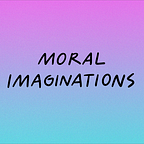Camden Imagines Participant Blogs
If we can’t imagine the future we want to see, how can we make it happen?
Imagining a truly collaborative and participatory future — by Sue Sheehan
This blog is part of a series of blogs written by the participants of the Camden Imagines programme. This eight week training introduced council officers and public servants to the skills of collective imagination and horizontal leadership to empower them to become agents of change in the borough.
Sue is on the Participation team at Camden Council. She works to build collaboration between businesses and the community in Kilburn, to collectively imagine a better high street. She set up the Camden Co-production network and supported voluntary and mutual aid groups during the pandemic. She also set up Think & Do Camden, a community space for climate and social action. In this blog, Sue explains why imagination is a vital tool for creating community engagement.
Faced with budget cuts at a time of increasing demand for services due to the converging crises of the cost of living and the climate crisis, combined with growing inequality, Camden Council is embracing the concept of imaginative activism. At the same time, the Council has a strong drive to increase participation and enable social action in the borough.
I want to use this blog to think about why these two ways of working are mutually supportive and how they can help us achieve the radical transformation that we need.
I am part of the Participation team and over the last few years I have noticed how much more imaginatively the community thinks than we do in the council. For example I worked with Think & Do and they had walls in their shop in Kentish Town asking people “what if” questions such as “what if Camden produced zero waste”, or “what if Camden produced all its energy locally”. This led to a whole series of conversations and small projects that are working to address these issues.
During the lockdown the conversation continued and Think & Do produced the Camden Future Journal — an imaginative banquet of ideas and ways of thinking differently that also gives hope and a general feeling of positivity and wellbeing. People are much more willing to get involved and participate in making Camden a better place if they feel positive about it. You can read more about the Camden Future Journal here.
If we can get into a space where we imagine the future we want to see we often start to frame the conversation differently. Council officers are constrained by budgets and demands on their time, but when communities come up with their own solutions they are often lower-cost solutions. We saw this in the pandemic when neighbours stepped up to help neighbours and people packed food parcels or went shopping for those people who suddenly became trapped in their homes.
The cost of taking a bit more care of people is zero. The cost of the council providing food for people is huge. People feel good if they can do something helpful for someone else and they are consequently much more likely to be socially active in their communities. That’s not to say that the community food projects that have remained don’t need funding and support, but they are still providing better, local solutions than the council could provide itself.
It’s easy to understand how solutions like the ones above can come about at a time of intense crisis, but we are still in crisis now. We have multiple crises all colliding with one another. Rob Hopkins, whose book “From What is to What if inspired the Think & Do work, came to speak to the imagination activism training group. He highlighted a recent UN statement that said if we want to stay below 1.5 degrees of global warming we need “a radical transformation of society”. He noted that the press reported this with “we are doomed” type headlines. What if they had run headlines like “let’s radically transform society” instead? How much better would that feel? How much more positive action would we be taking?
Through the work we have been doing over the last few years, and through the imagination activism course, which staff from across the council have participated in, it’s possible to see that by unlocking our own imaginations and sharing that process with people in our community, radical change is possible. Indeed, the opposite is also true — if we can’t imagine the future we want to see, how can we make it happen? It will require us to work in partnership with people, facilitating and enabling social action and handing over some power to enable them to lead, but we have that ambition as a council already. Now we just need to use our imaginations to make it happen.
This blog is part of a series written by Camden’s Imagination Activists as part of their Imagination Activism programme called “Camden Imagines”. To read the other blogposts in the series, please visit this link.
